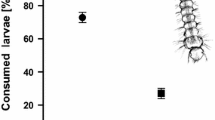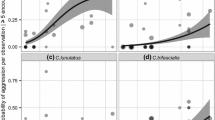Synopsis
Individual mosquitofish, Gambusia affinis, can adopt a broad range of attack selectivities. In part, this variation can be explained by the past experiences of a fish. Individuals selected the more profitable Ceriodaphnia dubia (Cladocera) over less profitable cyclopoid copepods to a greater degree after being exposed to both prey types than did individuals experienced with only one of the prey types. Feeding rate (biomass ingested per unit time) declined with increased attack specialization on the profitable prey (Ceriodaphnia) when such prey were scarce, a result in agreement with assumptions of optimal diet theory. When profitable prey were abundant feeding rate was a bimodal function of the intensity of specialization on profitable prey; fish that specialized on cyclopoid copepods (the less profitable prey type) fed at higher rates than did generalists. This may be the result of antagonistic learning that precluded feeding efficiently on more than one type of prey at a time. The data are consistent with the hypothesis that rejection of unsuitable prey involves a time cost. The two preceeding aspects of foraging behavior, which are absent from most optimal diet models, could lead to failure in predicting the attack specialization of some predators, An additional aspect of the results was the generally weak relationship between feeding efficiency and specialization behavior. This suggests that feeding rate may not have been as tightly linked to the specialization behavior a predator adopts as is assumed by current foraging theory.
Similar content being viewed by others
References cited
Allan, J. D. 1981. Determinants of diet of brook trout (Salvelinus fontinalis) in a mountain stream. Can. J. Fish. Aquat. Sci. 38: 184–192.
Bayliss, D.E. 1982. Switching by Lepsiella vinosa (Gastropoda) in South Australian mangroves. Oecologia 54: 212–226.
Bence, J.R. 1985. Selection of prey by the mosquitofish and its predatory impact on invertebrates. Ph. D. Thesis, University of California, Santa Barbara. 272 pp.
Bence, J.R. & W.W. Murdoch. 1986. Prey size selection by the mosquitofish and its relation to optimal diet theory, Ecology (in press).
Beukema, J.J. 1968. Predation by the three spined stickleback (Gasterosteus aculeatus L.): the influence of hunger and experience. Behavior 30: 1–126.
Bohl, E. 1982. Food supply and prey selection in planktivorous cyprinidae. Oecologia 53: 134–138.
Brooks, J.L. & S.I. Dodson. 1965. Predation, body size, and composition of plankton. Science 150: 28–35.
Bryan, J.E. 1973. Feeding history, parental stock, and food selection in rainbow trout. Behavior 45: 123–153.
Bryan, J.E. & P.A. Larkin. 1972. Food specialization by individual trout. J. Fish. Res. Board Can. 29: 1615–1624.
Chesson, J. 1983. The estimation and analysis of preference and its relationship to foraging models. Ecology 59: 211–215.
Connell, J.H. 1975. Some mechanisms producing structure in natural communities. pp. 460–491. In: M.L. Cody & J.M. Diamond(ed.) Ecology and Evolution of Communities, Harvard University Press, Boston.
Cooper, S.D., D.W. Smith & J.R. Bence. 1985. Prey preferences of freshwater predators with different foraging strategies. Can. J. Fish. Aquat. Sci. 42: 1720–1732.
Cornell, H. 1976. Search strategies and the adaptive significance of switching in some general predators. Amer. Nat. 110: 317–320.
Curio, E. 1976. The ethology of predation. Springer-Verlag, New York. 250 pp.
Dawkins, M. 1971. Shifts of ‘attention’ in chicks during feeding. Animal Behavior 19: 575–582.
Dill, L.M. 1983. Adaptive flexibility in the foraging behavior of fishes. Can. J. Fish. Aquat. Sci. 40: 398–408.
Emlen, J.M. & M.G.R. Emlen. 1975. Optimal choice in diet: test of a hypothesis. Amer. Nat. 109: 427–435.
Emlen, J.M. 1984. Population biology — the coevolution of population dynamics and behavior. MacMillan Publishing Company, New York, 547 pp.
Glasser, J.W. 1982. A theory of trophic strategies: the evolution of facultative specialists. Amer. Nat. 119: 250–262.
Fulton, R.S. 1985. Predator-prey relationships in an estuarine littoral copepod community. Ecology 66: 21–29.
Hall, D.J., W.E. Cooper & E.E. Werner. 1970. An experimental approach to the production dynamics and structure of freshwater communities. Limnol. Ocean. 15: 839–928.
Holt, R. D. 1983. Optimal foraging and the form of the predator isocline. Amer. Nat. 122: 521–541.
Hubbard, S.F., R.M. Cook, J.G. Glover & J.J.D. Greenwood. 1982. Apostatic selection as an optimal foraging strategy. J. Anim. Ecol. 51: 625–634.
Hughes, R. 1979. Optimal diets under the energy maximization premise: the effects of recognition time and learning. Amer. Nat. 113: 209–221.
Kislalioglu, M. & R.W. Gibson. 1975. Field and laboratory observations on prey size selection in Spinachia spinachia (L.), pp. 29–41. In: H. Barnes(ed.) Proceedings of th 19th European Marine Biology Symposium, The Aberdeen University Press, Aberdeen.
Landenberger, D.E. 1968. Studies on selective feeding in the pacific starfish Pisaster in Southern California. Ecology 49: 1062–1075.
LeBrasseur, R.J. 1969. Growth of juvenile chum salmon (Oncorhynchus keta) under different feeding regimes. J. Fish. Res. Board Can. 26: 1631–1645.
Manly, B.F. 1974. A model for certain types of selection experiments. Biometrics 30: 281–294.
Mathias, J.A. & S. Li. 1982. Feeding habits of walleye larvae and juveniles: comparative laboratory and field studies. Trans. Amer. Fish. Soc. 111: 722–735.
McCauley, E. 1983. The estimation of the abundance and biomass of zooplankton in samples. pp. 228–262. In: J.A.D. Downing & F.H. Rigler(ed.) The Assessment of Secondary Productivity in Freshwaters, Blackwell Scientic Publications, Oxford.
McCauley, E. & F. Briand. 1979. Zooplankton grazing and phytoplankton species richness: field tests of the predation hypothesis Limnol. Ocean, 24: 243–252.
Milinski, M. & C. Loewenstein. 1980. On predator selection against abnormalities of movement: a test of an hypothesis. Zeit. für Tier. 53: 323–340.
Murdoch, W.W. 1969. Switching in general predators: experiments on predator specificity and stability of prey populations. Ecol. Monogr. 39: 336–353.
Murdoch, W.W., S. Avery & M.E. Smythe. 1975. Switching in a predatory fish. Ecology 56: 1094–1105.
Murdoch, W.W., M.A. Scott & P. Ebsworth. 1984. The effects of the general predator, Notonecta (Hemiptera) upon a freshwater community. J. Anim. Ecol. 53: 791–808.
Murdoch, W.W. & A. Oaten. 1975. Predation and population stability. Adv. Ecol. Res. 9: 1–131.
Paine, R.T. 1966. Food web complexity and species diversity. Amer. Nat. 100: 65–74.
Pulliam, H. R. 1974. On the theory of optimal diets. Amer. Nat. 108: 59–75.
Pyke, G.H. 1984. Optimal foraging theory: a critical review. Ann. Rev. Ecol. System. 15: 523–571.
Rosenthal, H. & G. Hempel. 1970. Experimental studies in feeding and food requirements of herring larvae (Clupea harengus L.). pp. 344–364. In: J.H. Steele(ed.) Marine Food Chains, Oliver & Boyd, Edinburgh.
Schmitt, R.J. & J.A. Coyer. 1982. The foraging ecology of sympatric marine fish in the genus Embiotoca (Embiotocidae): importance of foraging behavior in prey size selection. Oecologia 55: 369–378.
Vinyard, G.L. 1980. Differential prey vulnerability and predator selectivity: the effects of evasive prey on sunfish (Lepomis) predation. Can. J. Fish. Aquat. Sci. 37: 2294–2299.
Werner, E.E. & D.J. Hall. 1974. Optimal foraging and size selection of prey by the bluegill sunfish Lepomis macrochirus. Ecology 55: 1042–1052.
Werner, E. E. & D.J. Hall. 1979. Foraging efficiency and habitat switching in competing sunfishes. Ecology 60: 256–264.
Werner, E.E., G.G. Mittelbach & D.J. Hall. 1981. Foraging profitability and the role of experience in habitat use by bluegill sunfish. Ecology 62: 116–125.
Werner, E.E., G.G. Mittelbach, D.J. Hall & J.F. Gilliam. 1983. Experimental tests of optimal habitat use in fish: the role of relative habitat profitability. Ecology 64: 1525–1539.
Winfield, I.J., G. Peirson, M. Cryer & C. Townsend. 1983. The behavioral basis of prey selection by underyearling bream Abramis breaa (L.) and roach Rutilus rutilus (L.). Freshwater Biol. 13: 139–149.
Wright, D. I. & W.J. O'Brien. The development and field test of a tactical model of the planktivorous feeding of white crappie (Pomoxis annularis). Ecol. Monogr. 54: 65–98.
Zaret, T. M. 1980. Predation and freshwater communities. Yale University Press, New Haven. 187 pp.
Author information
Authors and Affiliations
Rights and permissions
About this article
Cite this article
Bence, J.R. Feeding rate and attack specialization: the roles of predator experience and energetic tradeoffs. Environ Biol Fish 16, 113–121 (1986). https://doi.org/10.1007/BF00005164
Received:
Accepted:
Issue Date:
DOI: https://doi.org/10.1007/BF00005164




